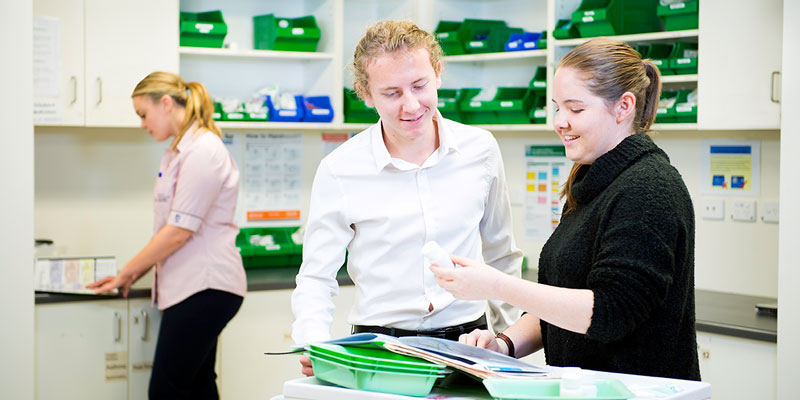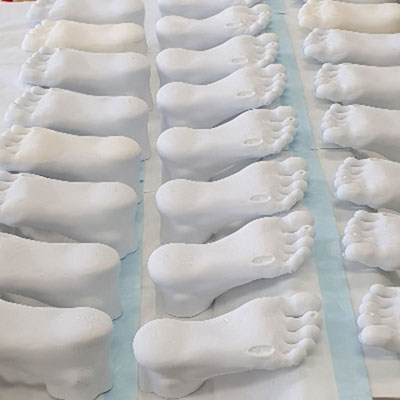Health placements are going ahead – and they're needed more than ever
By Cyndal King and Jessica Sanderson
 HEALTH UniSA students on placement are helping to receive and organise the SA pharmacy stock allocated for COVID-19 related usage. Pictured are UniSA students Tom Mitchell and Kathryn Hunt in a time before the outbreak of COVID-19.
HEALTH UniSA students on placement are helping to receive and organise the SA pharmacy stock allocated for COVID-19 related usage. Pictured are UniSA students Tom Mitchell and Kathryn Hunt in a time before the outbreak of COVID-19. > Leg up for podiatry students as 3D-printed feet put them strides ahead of the rest
Pharmacy, laboratory medicine, and nursing students from the University of South Australia are playing key roles in supporting South Australia’s COVID-19 response through clinical placements.
UniSA Nursing students are helping SA Pathology to test patients at COVID-19 clinics at the Repatriation General Hospital and Hampstead Hospital. UniSA Pharmacy students at the Royal Adelaide Hospital, part of the Central Adelaide Local Health Network (CALHN), are undertaking activities directly in support of COVID-19; assisting with managing the increased medicine supplies that ICUs require to support ventilated patients.
SA Pathology and the Royal Adelaide Hospital have requested UniSA health student placements with them be adjusted to assist with the work overflow.
Senior Pharmacist at SA Pharmacy, CALHN, Yu Ting Sim, says that the students have been a wonderful support in maintaining health services and ensuring their hospitals have stock of essential medicines for COVID-19.
“The COVID-19 pandemic has had a significant impact on hospital pharmacy departments, particularly in medicines procurement and distribution,” she says.
“UniSA fourth-year pharmacy students on placement at public hospitals are playing an important role in helping the sites with medicines storage in pharmacy, refilling ward imprest supplies and ensuring safe and timely supply of medications for hospital patients.
“The students have valued understanding the integration and importance of these tasks as part of the bigger planning efforts during the pandemic, and the importance of communication in optimal pharmacy service delivery for patient care.”
Pro Vice Chancellor for Student Engagement and Equity, Professor Carol Grech, says that in keeping with the federal Department of Health and SA Health’s current advice, health departments are supporting student placements.
“Indeed, in these extraordinary times, they want to work with universities to facilitate students at the appropriate level to assist in the broader health workforce response,” Prof Grech says.
“UniSA health professional students are well prepared and committed to the health of South Australians and are ready to rise to the challenges currently facing the health care sector.”
Many Laboratory Medicine students who are currently on placement with SA Pathology have also been recruited to casual paid positions within the labs to help with overflow.
The students are currently being used in casual positions in some directorates where they have played a role to cover some of the work of SA Pathology staff who are currently focused on COVID-19, with no impact on their work placement.
UniSA fourth-year Bachelor of Laboratory Medicine (Honours) student Daniel Gunn has gained casual employment through his placement at SA Pathology.
“My SA Pathology placement has been an excellent experience in bridging the classroom to industry,” he says. “Given current circumstances, I've quickly gained greater independence within the lab, demonstrating competence enough to receive casual employment and assist in alleviating the increased workload.”
Students are also helping at the UniSA Health Clinics on campus, by conducting assessments and screening people as they enter and leave.
Prof Grech says UniSA will continue to work with placement providers to support UniSA students on professional practice placements in health settings, noting that some health agencies may have specific provisions that require them to cancel or postpone a placement.
“In these cases, we will work with affected students to ensure that they are not disadvantaged and if a student does not wish to undertake a placement due to their health, wellbeing or circumstances, then this too will be managed,” Prof Grech says.
Leg up for podiatry students as 3D-printed feet put them strides ahead of the rest
By Annabel Mansfield
 UniSA uses 3D-printed feet as a teaching tool.
UniSA uses 3D-printed feet as a teaching tool.3D-printed feet – complete with calluses, corns and fake toenails – will enable UniSA’s podiatry students to practise and fine-tune their podiatry skills from the comfort of their own home, ensuring they attain the required practical experience amid COVID-19.
It’s a massive coup for UniSA’s podiatry students who are required to gain about 1000 hours of clinical practice during their degree to be competent to practice – an issue that’s causing much concern for many universities as they grapple to compensate for face-to-face clinical experience.
Created and introduced in a world first podiatry training initiative last year, the foot models are part of a podiatry kit, which has been sent to all UniSA’s second-year podiatry students.
Leading podiatry expert and lecturer, UniSA’s Dr Helen Banwell, says the podiatry kit will deliver unique and realistic training experiences for students, to ensure they complete their degree within the allocated time.
“Clinical placements are one of the most critical learning aspects across all allied health degrees because they allow students to gain hands-on, practical experience. Yet, with social distancing, this is made so much harder, and many universities are finding it impossible to supplement this aspect of the degree,” Dr Banwell says.
“UniSA is in a unique position, not only because we have the only degree of its kind in South Australia, but also because our team’s forward thinking and creativity to conceive the 3D-printed feet as a teaching tool has really enabled us to adapt to these unforeseen circumstances.
“By providing our students with their own podiatry kit – which not only contains the 3D-printed foot, but also a variety of dressings, paddings, and disposable scalpels and instruments – we will be able to teach key podiatry skills remotely, to ensure that every one of our students is afforded the opportunity to finish their degree within the four years.”
With demand for podiatrists continuing to rise, there is an acute need for highly skilled professionals. In Australia, more than 300,000 people are at risk of diabetes-related foot disease on any given day. Dr Banwell says that despite the guidelines and uptake of podiatry services, diabetic-foot disease accounts for around 27,600 public hospital admissions, 4400 lower extremity amputations and 1700 deaths each year.
“More than 80 per cent of diabetes-related amputations are preventable with best practice treatment and ongoing management,” Dr Banwell says. “But it’s only through first-class training and practice, such as we provide in the UniSA degree, that we can hope to change this.
“Using the podiatry kit, and online teaching tools, students will be able to assess, plan and practise treatment of a range of foot conditions. Plus, as they’ll be using their own set of tools, we’ll be able to show them how to prepare for sterilisation.”




